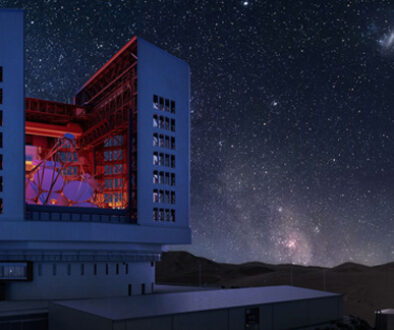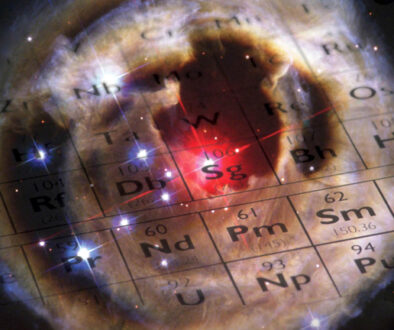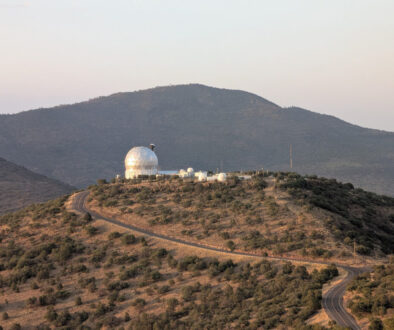Texas A&M Physicist Rupak Mahapatra Earns DOE Grant for Detector Research
For more than a decade, Texas A&M University high energy physicist Rupak Mahapatra has been making the devices that make detection of the particles believed to be behind dark matter and therefore nearly a quarter of the universe possible.

Mahapatra has been instrumental in positioning the international Super Cryogenic Dark Matter Search experiment at Soudan, Minn., as a world leader in the search for elusive weakly interacting massive particles (WIMP), which to date remain undetected. Earlier this month, his latest proposal outlining the next big thing in ultra-sensitive cryogenics was selected for funding by the United States Department of Energy (DOE) as part of a broader effort to advance detector research and development for high energy physics.
Mahapatra, a 2010 DOE Early Career Research Award recipient and a principal investigator since 2003 with SuperCDMS and the affiliated SuperCDMS SNOLAB experiment, will receive $460,000 through the Office of High Energy Physics in support of his proposal, Ultra-low Threshold Cryogenic High Voltage Detectors for WIMP Search and Coherent Neutrino Scattering Experiments. This augments the $1.675 million he previously secured for 2015-2018 as the principal investigator for the SuperCDMS program at Texas A&M, which also includes co-PIs David Toback, Nader Mirabolfathi and H. Rusty Harris.
Because scientists don’t actually know what dark matter particles look like, Mahapatra explains that the search has focused on a wide range of possible traits, including different masses and different probabilities of interacting with regular matter. The SuperCDMS SNOLAB experiment uses highly sophisticated detector technology and advanced analysis techniques to enable cryogenically cooled (almost absolute zero temperature at -460 degrees F) germanium and silicon targets to search for the rare recoil of dark matter particles, as evidenced by the extremely small energies deposited after colliding with the materials present in the detectors.


While it’s more typical in goal-setting to aim high, Mahapatra prefers going low — as low as the ultra-sensitive cryogenic detectors fabricated within his Texas A&M-based laboratory can go to help enable WIMP searches at the solar neutrino floor at unprecedentally low energy and recoil levels.
“A dark matter particle passes through us every second, yet we do not feel it due to their extremely rare interaction with ordinary matter,” said Mahapatra, a professor since 2008 in the Department of Physics and Astronomy and a member of the George P. and Cynthia Woods Mitchell Institute for Fundamental Physics and Astronomy. “In collaboration with Stanford, our group is leading the detector development for next-generation dark matter detectors utilizing cryogenically cooled semiconductor detectors with transition edge sensors.”
What starts in Mahapatra’s laboratory as bare germanium and silicon crystals is painstakingly transformed through a series of high-performance, semiconductor technology-driven steps. First, the crystals are characterized based on purity and then polished to detector-grade specifications. Next, they are enhanced with a thin layer of film, onto which their Texas A&M-developed transition edge sensors are photolithographically patterned. Finally, the film is cryogenically tested using liquid helium and then carefully packaged for transport for additional scientific testing and payload preparation.
Mahapatra says the same detector technology that is driving the field of low-mass WIMP searches is also at the forefront of the searches for beyond Standard Model (BSM) physics using reactor neutrinos. Due to the low energy recoils expected from WIMP and coherent elastic neutrino nucleus scattering (CENNS), he says the primary challenge is the availability of large mass detectors (ideally, at least a kilogram) with low energy thresholds at sub-keV [kiloelectronvolts] — a challenge his research hopes to overcome by developing a prototype two-stage detector that may allow discrimination-based WIMP searching down to 100 eV [electronvolt] recoils.


“The lack of such a technology has prevented measurement of the CENNS process predicted by the Standard Model,” Mahapatra said. “Understanding this process using reactor neutrinos will allow the next-generation dark matter experiments to subtract the CENNS background from observed rates for a possible WIMP detection.”
Mahapatra and Mirabolfathi currently are designing and developing a few cutting-edge new detector ideas that may dramatically improve the scientific potential of dark matter searches as well as those at the forefront of new physics using coherent scattering of neutrinos. He says the Mitchell Institute Neutrino Experiment at Reactor (MINER), which is housed at the Texas A&M Nuclear Science Center, will be used as a probe for such progressive horizons.


“MINER will leverage an excellent combination of existing and future detector technologies with the opportune use of the local reactor facility to provide sensitivity to discoveries within a short span of two or three years, with definitive CENNS detection with a few months of data,” Mahapatra said. “The experiment has sensitivity to exciting new physics, from sterile neutrinos and Z’ bosons to non-standard interactions and neutrino magnetic moment.”The SuperCDMS collaboration’s work is funded by the DOE and the National Science Foundation as well as the Natural Sciences and Engineering Research Council of Canada (NSERC). For more information, go to http://cdms.berkeley.edu/.
To learn more about Mahapatra’s involvement with the collaboration and related research, visit http://people.physics.tamu.edu/mahapatra/.
# # # # # # # # # #
About Research at Texas A&M University: As one of the world’s leading research institutions, Texas A&M is at the forefront in making significant contributions to scholarship and discovery, including that of science and technology. Research conducted at Texas A&M represented annual expenditures of more than $892.7 million in fiscal year 2016. Texas A&M ranked in the top 20 of the National Science Foundation’s Higher Education Research and Development survey (2015), based on expenditures of more than $866.6 million in fiscal year 2015. Texas A&M’s research creates new knowledge that provides basic, fundamental and applied contributions resulting, in many cases, in economic benefits to the state, nation and world. To learn more, visit http://research.tamu.edu.
-aTm-
Contact: Shana K. Hutchins, (979) 862-1237 or shutchins@science.tamu.edu or Dr. Rupak Mahapatra, (979) 229-4196 or mahapatra@physics.tamu.edu


